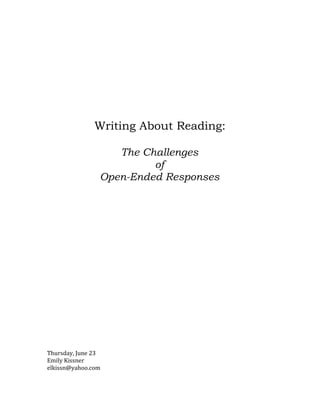
Psy kissner
- 1. Writing About Reading: The Challenges of Open-Ended Responses Thursday, June 23 Emily Kissner elkissn@yahoo.com
- 3. Constructed Response Frame SEE Organizer Directions: The acronym SEE stands for Statement, Examples, and Explanation. This is one way that you can remember what to put in your constructed responses. Statement I (would like, would not like) to own and train sled dogs. Examples Text Example 1: Text Example 2: Text Example 3: Explanation (Explain how your examples relate back to your answer) From The Forest AND the Trees by Emily Kissner
- 4. What Is A Tsunami? Do you like to play in waves at the beach? If so, you know that some waves are big, and some are small. But there are waves that are bigger than any you might see on a regular day at the beach. These waves are called tsunamis. What causes tsunamis? They are not regular ocean waves. A tsunami is a huge wave that is caused by an earthquake at sea. When an earthquake causes the sea floor to rise or drop, water is displaced. This makes a wave that can travel for many miles in the ocean. As the water becomes shallow close to the land, the wave becomes huge. Tsunamis can have terrible effects. The great wave of water crashes upon the coast with huge force. This force can knock over buildings, tear down forests, and even destroy entire towns and villages. Tsunamis can be deadly and kill many people.
- 5. Tsunami Open-Ended Response What are some effects of a tsunami? Support your answer with two specific details from the text. Tsunami Open-Ended Response What are some effects of a tsunami? Support your answer with two specific details from the text. A tsunami has many effects. For example,
- 6. . Another effect is . Finally, . Emily Kissner 2011
- 7. Literature Circle Questions Anytime Questions A1. Choose a character. Identify at least two traits of that character. Be sure to cite specific evidence from the text to support your details. A2. Choose a favorite sentence or quote from what you have read so far. Be ready to explain how it is important to the reading and why you like it. A3. Find an example of dialogue that shows what a character is like. Explain how the dialogue shows the character’s traits. A4. Which character in this book is the most like you? Why? A5. Share an inference that you made. Explain the text details and background knowledge that helped you to make the inference. A6. Find a word or phrase that is tricky to understand. Explain what the word or phrase means. (Be sure to write down the page number.) Questions for the beginning of a book B1. What is the setting (time and place) of your book? Which setting details are the most interesting to you? B2. How does the author begin the book? Is it an effective introduction? Be ready to explain your ideas. B3. Why is the conflict in this book? What guesses do you have for how it will be resolved? Questions for the middle of a book C1. What is the main problem in the book? How is the character attempting to solve it? C2. Find a place where you agree or disagree with a character’s decision. Explain the event, and your feelings about it. C3. Find some details that describe the setting. How is it important to the story? Would the story be different in a different time and place? C4. Choose a character who is not the main character. How is this character important to the story. What role do they play? Would the story be different without this character? Questions for the end of a book D1. Discuss the theme of the book. What is the big message? Why do you think this? D2. Choose a character who changed—either in emotions, traits, or attitudes. How did the character change? Why was this important? D3. How is the conflict resolved? D4. What is the most important event from the book? Why do you think that this is important? Emily Kissner 2011
- 11. Pennsylvania Keystone Literature Exam
